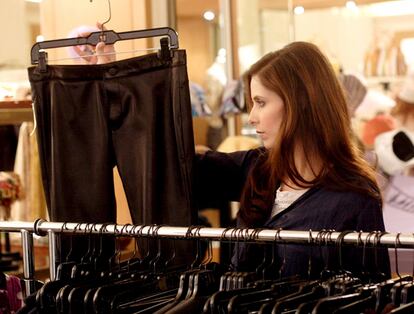Consumer guilt, or when refraining from buying new clothes becomes a trend
While many continue to feast on fast fashion, some buyers have developed a conscience, including several TikTok users who take part in challenges to ‘fast’ from shopping

The situation will feel familiar to many. With a closet full of clothes—and without a second thought—you go ahead and add a cashmere sweater made by your favorite brand to your online shopping cart. As the transaction is processed, you convince yourself that you are making a good purchase while you hush your brain’s incontestable objections: it is really a basic item, the price is unbeatable, you will wear it all the time. Still, that feeling of guilt that comes when you buy something you don’t really need is enough to overshadow any hint of happiness the confirmation email of your purchase might spark in you. This phenomenon is neither new nor exclusive to shopping (for instance, some people suffer from eco-guilt, the sense of shame for not doing enough for the environment).
In Sweden, they have a term, kopskam, to refer to that feeling of shame that a person experiences when buying unnecessary clothes. The concept has gained popularity in recent years in a country where climate activism has built momentum thanks to personalities such as Greta Thunberg, from Stockholm, who has stated more than once that she never buys new clothes. It is not the first time that a concept of this kind emerges from this country: in 2018, the neologism flysgkam (feeling guilty about flying by plane) echoed through the world media, a term that in turn gave rise to an opposing movement called tagskyrt—taking pride in traveling by train, a less polluting means of transportation.
In addition to the concern for the environment, the phenomenon is also linked to the need to explore other forms of consumption. Thus, it could be defined as a response to the unbridled consumerism that the textile industry has promoted since the 1990s, when the factories were outsourced to countries where labor is cheap and worker rights are non-existent, clothing became highly affordable and production exploded, with tens of thousands of new garments entering the market every day. We quickly got used to buying dresses for $10 and t-shirts for $5. The success of ultra-fast fashion giants among the younger generations shows how deeply rooted this form of fast-paced consumption has become. However, opposite those who continue to bet on that disposable fashion, there are buyers who have developed a conscience – and a feeling of consumer guilt.
How to deal with that kopskam? Dr. Núria Aragay Vicente, a psychology specialist at the Brain 360 Institute, mentions the importance of recognizing and fighting this feeling of guilt, alluding to some tools “to be able to make pleasure purchases that don’t spur a feeling of lack of control or negative consequences.” Among them, she suggests “setting a maximum amount of pleasure products that we want to buy each month” or shopping offline, in brick-and-mortar stores, “where we can see the object, try it, calmly analyze if it’s right for us,” she explains.
Shopping through a screen
E-commerce has made life much easier for us by simplifying all processes to a minimum; this, along with some fine-tuned personalized advertising, makes things much harder for people who wish to spend less on fashion. If you are among those that expand their wardrobe on a monthly basis, you are aware that you really do not need the vast majority of the clothes you buy.
While the digital universe conspires to arouse this unbridled consumption, new challenges on social networks like TikTok dare people to “fast from fashion” and stop buying for several months. TikToker @ru_pitman exemplifies the trend in a video where she shares several lessons she has learned after seven weeks (of a six-month goal) of not buying any clothes: “It gets easier the longer the time goes.” Meanwhile, on the opposite side of the spectrum, the popular clothing and makeup hauls—where a content creator flaunts everything they bought at a certain store, usually a fast fashion chain—continue to accumulate countless views.
But the guilt we feel when we buy clothes we do not need is not exclusively linked to environmental awareness; it depends on each person. Inma Brea, coach and expert in human behavior, explains that “the feeling of guilt that some people experience when buying something they don’t need depends to a large extent on their values and beliefs about money, their financial education and the influence of their environment. A person can feel guilty for spending more than they can afford or for the environmental and social impact of the excessive production and consumption of material goods.” The expert also finds similarities between kopskam and the guilty relationship that some people develop with food.
Second hand and revamped clothes
It is not fortuitous that the current popularity of vintage fashion coincides with the rise of environmental awareness. But if you are not looking to invest in new clothes, there are more options: revamping old or deteriorated garments is becoming another way of advocating for sustainable consumption. Of course, the practice has not gone unnoticed by the marketing experts behind the big brands, many of whom have implemented free repair services.
Any of these alternatives could mitigate that shame you feel when buying too many clothes. As for the textile industry, however, the kopskam phenomenon does not seem to be affecting it much.
Sign up for our weekly newsletter to get more English-language news coverage from EL PAÍS USA Edition
Tu suscripción se está usando en otro dispositivo
¿Quieres añadir otro usuario a tu suscripción?
Si continúas leyendo en este dispositivo, no se podrá leer en el otro.
FlechaTu suscripción se está usando en otro dispositivo y solo puedes acceder a EL PAÍS desde un dispositivo a la vez.
Si quieres compartir tu cuenta, cambia tu suscripción a la modalidad Premium, así podrás añadir otro usuario. Cada uno accederá con su propia cuenta de email, lo que os permitirá personalizar vuestra experiencia en EL PAÍS.
¿Tienes una suscripción de empresa? Accede aquí para contratar más cuentas.
En el caso de no saber quién está usando tu cuenta, te recomendamos cambiar tu contraseña aquí.
Si decides continuar compartiendo tu cuenta, este mensaje se mostrará en tu dispositivo y en el de la otra persona que está usando tu cuenta de forma indefinida, afectando a tu experiencia de lectura. Puedes consultar aquí los términos y condiciones de la suscripción digital.











































